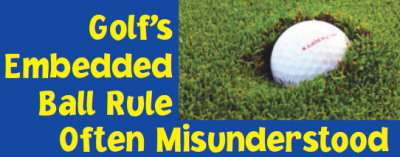Golf’s Embedded Ball Rule Often Misunderstood
Most golfers believe that an embedded ball is automatically entitled to a free drop, no matter where the ball lies. This is not entirely correct. Rule 25-2 states, “A ball embedded in its own pitch-mark in the ground in any closely mown area through the green may be lifted, cleaned and dropped, without penalty, as near as possible to the spot where it lay but not nearer the hole. The ball when dropped must first strike a part of the course through the green. ‘Closely mown area’ means any area of the course, including paths through the rough, cut to fairway height or less.”
Now, this is interesting in and of itself, because the term “fairway” is not defined anywhere in the rule book! Why would golf’s rules-makers put in a Rule with such vagueness? Kendra Graham, a former senior USGA rules official, stated on Golf Channel several years ago that the Royal & Ancient wanted it that way, so the USGA went along. This doesn’t seem to make much sense, because the term “through the green” is so prevalent in the Rules, and easily defined. But, as the phrase of the day goes, it is what it is.
So, relief from an embedded ball in the rough is not automatic. To get relief from a ball embedded somewhere other than the fairway, a Local Rule must be enacted. The wording the USGA recommends is “Through the green, a ball that is embedded in its own pitch-mark in the ground may be lifted, without penalty, cleaned and dropped as near as possible to where it lay but not nearer the hole. The ball when dropped must first strike a part of the course through the green.” An exception is that “A player may not take relief under this Local Rule if the ball is embedded in sand in an area that is not closely mown.”
This Local Rule came into play on an episode of The Big Break Indian Wells several months ago on Golf Channel. One of the competitors skulled a greenside bunker shot into what appeared at first to be the lip of the bunker. Upon closer inspection, the ball was no longer in the bunker, but instead was embedded in the ground just above the lip. This was not a sandy area as it was a grassy area, so the player was entitled to a free drop. He dropped the ball as near as possible to the spot, the ball rolled twice back into the bunker, and he was allowed to place it.
One of the features of the Local Rule is that a ball embedded in sand that is not in a closely mown area may not be moved without penalty. This might be in the case of a waste area, for example, or in a sandy area in the rough. Most golfers would probably try to take free relief, but this is not allowed.
Another misconception of the embedded ball rule is that some golfers think that you can drop within a clublength of the place where the ball was embedded. The Rule is clear that the ball must be dropped as near as possible to the spot where the ball did embed.
The Rules are not there to necessarily punish the player, but they are also there to help the player. Unfortunately, too many golfers (and teachers) don’t have the understanding that they should. Make sure you know the common Rules of Golf well, so your students will get the correct information they need.





